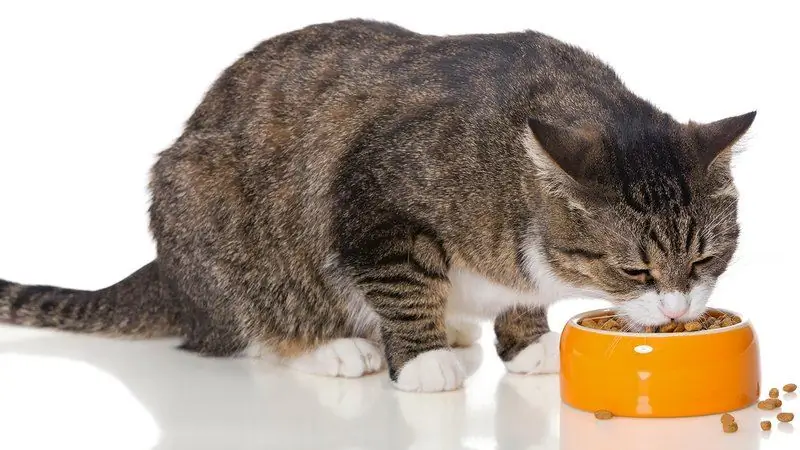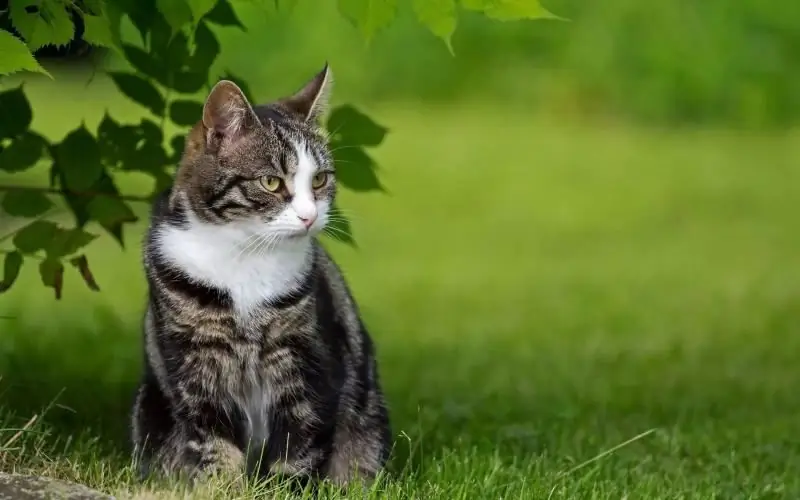
Table of contents:
- Author Bailey Albertson [email protected].
- Public 2024-01-17 22:26.
- Last modified 2025-01-23 12:41.
Vomiting white foam in a cat: how to help her

In a number of situations, cats vomit white foam, which occurs when there is no content in the stomach and consists of saliva, gastric mucus and gastric juice, as well as air bubbles. The owner should distinguish between when the cat needs help and when it is not worth worrying about.
Content
-
1 When vomiting white foam in cats is not a sign of illness
1.1 Video: Dangerous and Non-Hazardous Vomiting in Pets
-
2 Vomiting of white foam in cats as a symptom of the disease
- 2.1 Additional symptoms confirming the diagnosis
- 2.2 Video: Vomiting white foam in cats
- 2.3 Additional diagnostic methods
- 2.4 Video: what to do with vomiting in cats
-
3 How to treat a cat
3.1 Photo gallery: medication for vomiting in a cat
- 4 How to give first aid to a cat
- 5 Medicines to prevent vomiting in cats
- 6 Recommendations from veterinarians
When vomiting white foam in cats is not a sign of illness
In some conditions, vomiting of white foam has a physiological character and performs a protective function:
-
The presence of trichobezoars in the stomach - lumps of hair that the cat swallows during self-care, especially during molting. If the foam contains hairballs, the cat should be given Malt Paste to promote elimination.

Bezoar Bezoars - hairballs that enter the cat's digestive system when licked
- A long period without food - in this way the cat evacuates excess gastric juice, which can harm the gastric mucosa.
- Foreign bodies accidentally swallowed by a cat - in this case, a previously swallowed object can be found in the vomit.
-
Eating herbs and houseplants that irritate the stomach and cause vomiting.

Cat eats weed Foam vomiting occurs after eating indoor flowers or grass
- Stress - a state of prolonged nervous tension in cats may be accompanied by vomiting, including white foam.
- During estrus and sexual hunting - cats and cats experience stress, and they also have appetite disorders, the result of all this can be vomiting of white foam.
-
During pregnancy, cats may vomit both due to the development of toxicosis in the early stages, and due to compression of the internal organs by an enlarged uterus in the later stages.

A pregnant cat lies on the floor Vomiting of white foam during pregnancy occurs both with toxicosis and with compression of the internal organs of the pregnant uterus
-
Taking some medications that irritate the mucous membranes of the digestive system, and also affect its peristalsis:
- antibacterial agents;
- cytostatics;
- proserin;
- magnesium sulfate.
- When a cat is rocked in transport - in this case, you should not feed the cat for 6-8 hours before the trip, and also give it a sedative.
In those cases when vomiting of white foam is not a sign of illness, it does not disturb the general well-being of the cat, does not affect its mobility and appetite. The nature of such vomiting is episodic, most often once, less often twice. If the cat has vomited three times, this is cause for concern.
Video: dangerous and non-dangerous vomiting in pets
Vomiting of white foam in cats as a symptom of the disease
Vomiting of white foam can occur with the following diseases in a cat:
-
Infectious - vomiting occurs both due to the developed intoxication and due to a disruption in the functioning of the digestive system caused by an infectious agent that provoked:
- panleukopenia;
- coronavirus enteritis;
- calicivirus.
-
Chronic diseases of the digestive system:
- gastritis;
- pancreatitis;
- fatty hepatosis.
- Poisoning, including poor quality food.
-
Exchange violations:
- ketoacidosis in diabetes mellitus;
- uremia with renal failure.
- Helminthiasis - vomiting is caused by both intoxication and the direct penetration of helminths into the upper parts of the digestive system.
-
Inflammatory diseases of the respiratory tract:
- bronchitis, tracheitis, laryngitis - accompanied by a severe cough, which can cause reflex vomiting;
- pneumonia - vomiting can be caused by both coughing and severe intoxication.
- Constipation - activation of the peristaltic movements of the digestive system occurs, including antiperistalsis, as a result of which vomiting will appear.
- Tumors - vomiting occurs both due to disruption of the functioning of the digestive system, and due to intoxication, which is caused by the growth of neoplasms.
Additional symptoms confirming the diagnosis
The presence of additional symptoms will suggest a cause for the cat's discomfort. It is very important to report them to the veterinarian, this will allow a faster diagnosis. Various diseases can be accompanied by:
-
Infectious diseases:
- fever;
- thirst;
- general oppression;
- lack of appetite;
- diarrhea;
- discharge from the nose and eyes;
- the appearance of a skin rash or ulceration on the mucous membranes;
- discoloration of urine and stools;
-
pathological impurities in urine and stool:
- mucus;
- blood;
- pus.
-
Chronic diseases of the digestive system:
- decreased appetite;
- decrease in body weight;
- changes in stool consistency: diarrhea or constipation;
- decreased activity, apathy, unwillingness to play;
- irritability;
- abdominal pain;
-
a change in stool color:
- discoloration with obstruction of the biliary tract;
- redness with bleeding from the lower gastrointestinal tract;
- the appearance of blackness with bleeding from the upper parts of the digestive tract.
-
Poisoning - the symptoms depend on the type of toxin, as well as its amount that has entered the body:
- severe vomiting;
- restless behavior;
- a pronounced deterioration in well-being;
- lethargy, weakness;
- diarrhea;
- abdominal pain;
- an admixture of blood in vomit, stools, hemorrhages in the skin and mucous membranes in case of poisoning with rat poison;
- the development of renal failure - the absence of urine excretion against the background of a progressively worsening general condition;
- convulsions;
- coma and death.
-
Exchange violations:
-
uremia:
-
acute renal failure:
- a decrease in the amount of separated urine up to its absence;
- swelling;
- increased heart rate;
- diarrhea;
- general weakness;
- pain on palpation in the kidney area;
- the smell of urine from mucous membranes and cat fur;
- convulsions;
- coma and death.
-
chronic renal failure:
- separation of large amounts of watery urine;
- thirst;
- constipation;
- dry skin and mucous membranes;
- ulcerative stomatitis;
- the smell of urine from mucous membranes and cat fur;
- heart rhythm disorders;
- decrease in body weight;
- anemia;
- increased blood pressure;
- general weakness;
- convulsions;
- coma and death.
-
-
ketoacidosis:
- weakness;
- general oppression up to lethargy;
- diarrhea;
- decrease in body temperature;
- lack of appetite;
- coma and death.
-
-
Helminthiasis:
- general oppression;
- instability of appetite;
- decrease in body weight;
- alternating diarrhea and constipation;
- an admixture of blood in the stool;
- cough;
- allergic skin reactions;
- stomach pain;
- an increase in the size of the abdomen.
-
Inflammatory airway diseases:
- fever;
- thirst;
- weakness, general malaise;
- decreased appetite;
- discharge from the eyes and nose;
- cough;
- when listening to the lungs, dry or moist rales are determined, as well as weakening or increased breathing.
-
Constipation:
- absence of a chair for 3 days;
- bloating;
- abdominal pain;
- repeated and unsuccessful visits to the litter box, when the cat makes additional efforts.
-
Tumors. Clinical manifestations strongly depend on the location of the tumor, its type and stage of the process. The most common symptoms are:
- visible or tactile mass;
- weakness, general malaise;
- pain syndrome;
- anemia;
- an increase in peripheral lymph nodes;
- bleeding when the tumor decays.
Video: white foam vomiting in cats
Additional diagnostic methods
Additional diagnostic methods allow you to confirm the diagnosis:
-
For infectious diseases:
-
general blood test, in which there are:
- decrease or increase in the number of leukocytes;
- a relative increase in the content of red blood cells due to dehydration or a decrease due to hemolysis (destruction of red blood cells), as well as bleeding;
- increased ESR (erythrocyte sedimentation rate);
- increased hematocrit (red blood cells).
-
general urine analysis (most informative in case of kidney and urinary tract damage), which reveals:
- protein;
- leukocytes;
- erythrocytes;
- bacteria.
-
biochemical blood test (indicators depend on which organs are involved in the infectious process, as well as on the degree of impairment of their function), it is possible:
- an increase in bilirubin in case of liver damage, an increase in the level of hepatic transaminases (ALAT, ASAT);
- increased urea and creatinine with kidney damage;
- increased fibrinogen and C-reactive protein as indicators of the inflammatory process;
- violation of the content of plasma electrolytes.
- immunological tests for the determination of specific antibodies or antigens - allow you to accurately determine the causative agent of the disease by examining the biomaterials taken from the animal;
- bacteriological method - isolation of the pathogen by inoculation on a culture medium for its identification;
-
X-ray methods:
- chest x-ray allows you to confirm or deny the presence of pneumonia, bronchitis, pleurisy, changes in the shape and size of the heart;
- X-rays of the joints are performed for infectious arthritis;
- X-ray of the skull to clarify the condition of the paranasal sinuses, as well as the roots of the teeth.
-
ultrasound examination allows:
- to clarify the size and shape of internal organs, blood flow in them;
- detect inflammation;
- visualize pathological formations: stones, tumors, abscesses;
- see the accumulation of fluid in the body cavities.
-
-
For chronic diseases of the digestive system:
- complete blood count: possible leukocytosis, anemia, increased ESR;
- biochemical blood test: possibly an increase in bilirubin, amylase, a decrease in protein, an increase in the level of hepatic transaminases, an increase in the level of gamma-glutamate transferase during bile stasis;
- coprogram (study of feces to determine its properties): mucus, blood, intestinal epithelial cells, undigested food components, changes in the normal composition of the bacterial flora can be determined;
- Ultrasound of the abdominal organs: allows you to clarify the size, shape and structure of the abdominal organs; presence or absence of stones and tumors;
- endoscopic methods - allow you to assess the condition of the mucous membrane of internal organs.
-
In case of poisoning, the changes are determined by the type of poisoning, usually they are not of a specific nature:
-
complete blood count - often reflects dehydration:
- increased hematocrit;
- a relative increase in the number of all blood cells.
-
general urine analysis:
- with the development of renal failure, protein, erythrocytes, cylinders appear in the urine;
- with hemolysis - destroyed erythrocytes;
- with toxic liver damage - bilirubin crystals.
-
-
With metabolic disorders:
-
uremia:
- complete blood count: with chronic renal failure, anemia is characteristic;
- biochemical blood test: an increase in the level of creatinine, urea, amylase, a violation of the content of plasma electrolytes;
-
general urine analysis:
- in acute renal failure, erythrocytes, protein, casts are found;
- with chronic renal failure - low urine specific gravity and density.
-
ketoacidosis:
-
general blood analysis:
- increased hematocrit;
- a relative increase in the number of all blood cells.
-
blood chemistry:
- increased glucose levels;
- acidosis (increased blood acidity);
- decreased levels of potassium and calcium.
- general urinalysis: glucose, maybe protein with nephropathy.
-
-
-
With helminthiasis:
- general blood test - the content of eosinophils is increased, there may be anemia;
- coprogram - eggs of worms are found, as well as their fragments.
-
For inflammatory diseases of the respiratory tract:
- complete blood count - leukocytosis, increased ESR;
- chest x-ray - signs of bronchitis, pneumonia, or pleurisy.
- In case of constipation - changes in laboratory tests are nonspecific and may be absent, a plain X-ray of the abdominal cavity may show enlarged bowel loops.
-
If there is a tumor:
- complete blood count - often anemia, increased ESR;
-
biochemical blood test - changes depend on the affected organ, the degree of impairment of its function, the stage of the tumor process:
- decreased total protein;
- increased lactate dehydrogenase;
- increased bilirubin with damage to the liver and its ducts.
- chest x-ray - allows you to clarify the presence of masses;
-
abdominal radiography:
- overview - reveals the presence of intestinal obstruction;
- with contrast - tumor formations.
- Ultrasound of the abdominal organs - allows you to identify tumors of the internal organs;
- endoscopic methods - allow you to identify tumors of hollow organs, take samples for analysis;
- diagnostic laparoscopy - allows you to examine the internal organs from the side of the abdominal cavity;
- CT, MRI - well visualize tumors of complex localizations, especially the brain and spinal cord;
- histological method - the study of a sample of a tumor in order to determine its type.

To clarify the cause of vomiting, additional examination methods are often needed.
Video: what to do with vomiting in cats
How to treat a cat
Treatment depends on the type of disease:
-
Infectious Diseases - Home Treatment; if necessary - infusion therapy (droppers) in a hospital setting:
-
antibacterial drugs:
- Sinulox;
- Tsiprovet.
- hyperimmune sera;
-
immunomodulators:
- Gamavite;
- Fosprenil.
-
-
Chronic diseases of the digestive system - home treatment:
-
antibacterial and antimicrobial drugs:
- Sinulox;
- Metronidazole;
- Doxycycline.
-
antispasmodics:
- Papaverine;
- Drotaverinum.
-
enzyme preparations:
- Creon;
- Festal.
-
hepatoprotectors:
- Heptral;
- Essentiale.
-
-
Poisoning - severe poisoning is treated in a hospital, including in intensive care, mild cases - at home:
-
sorbents:
- Smecta;
- Activated carbon.
- laxatives (magnesium sulfate);
- diuretics (Lasix).
-
- Metabolic disorders - ketoacidosis and uremia in acute renal failure are urgent conditions, treatment is carried out in a veterinary hospital.
-
Helminthiasis - home treatment with antihelminthic agents:
- Milbemax;
- Pratelom.
-
Airway Inflammation - Home Treatment:
-
antibiotics:
- Sinulox;
- Baytril.
-
mucolytics:
- Mukaltin;
- Bromhexine.
-
-
Constipation - home treatment with laxatives:
- Lactusan;
- Bisacodyl;
- vaseline oil.
-
Tumors:
- surgical treatment in a hospital setting;
- cytostatic therapy by courses in a hospital setting.

Vomiting is always a symptom, treatment is started only after the veterinarian has established its cause
Photo gallery: medicines for vomiting in a cat
-

Milbemax - Milbemax is prescribed for helminthiasis
-

Bisacodyl - Bisacodyl is a laxative drug that stimulates intestinal motility
-

Sinulox suspension - Sinulox helps with bacterial infections
-

Creon - Creon improves digestion
-

Smecta - Smecta is prescribed for poisoning as a sorbent
How to give first aid to a cat
If vomiting occurs, you should:
- Remove food from the cat's access, evaluate its quality.
- Examine the pet, measure its body temperature.
- Determine if there are other symptoms.
- In case of violation of the general well-being of the cat, the presence of other symptoms, frequent vomiting, consult a doctor.
If you suspect acid or alkali poisoning, vomiting should not be induced, an appeal to the veterinarian should be urgent.
Medicines to prevent vomiting in cats
Drugs that prevent vomiting are prescribed only after establishing its cause:
-
antiemetics of central action:
-
Cerucal;

Cerucal Cerucal is an effective and safe drug that can be prescribed to reduce the intensity or stop the gag reflex
- Torekan.
-
-
means blocking the secretion of hydrochloric acid:
- Famotidine;
- Omeprazole;
- Almagel.
-
hepatoprotectors:
- Heptral;
- Essentiale;
- Hofitol.
-
sorbents:
- Smecta;
- Enterosgel.
-
antispasmodics:
- Papaverine;
- Drotaverin;
- Platyphyllin.
Veterinarian recommendations
Vomiting of white foam in cats can occur as a normal physiological phenomenon, and as a symptom of a number of diseases. If vomiting is combined with malaise in the cat, as well as if there are other symptoms, the animal should be taken to the clinic. To confirm the diagnosis and the correct selection of treatment, an additional examination is required. Only a veterinarian can diagnose and prescribe treatment.
Recommended:
Is It Possible To Soak Dry Food For Cats And Cats: Features Of Soaking For Adult Animals And Kittens, Recommendations Of Veterinarians

Is it possible and when it is necessary to soak dry food for cats and kittens, how to do it correctly, is it possible to store soaked food. Veterinarian recommendations
How To Train A Cat Or Cat To A Scratching Post, Including In The Form Of A House: Features Of Training Kittens And Adult Animals, Recommendations And Reviews

Why cats need to sharpen their claws. How to draw your pet's attention to a device. What to do if your cat doesn't want to use the scratching post
A Cat Or A Cat Pees With Blood: The Reasons For The Appearance Of Blood Urine In Kittens And Adult Animals, With What It May Be Connected, How To Treat

What does an impurity of blood in urine look like in a cat, types of hematuria, causes, list of diseases, diagnostic methods, first aid measures, prevention
Renal Failure In Cats And Cats: Symptoms, Treatment, How To Save A Kitten And An Adult Animal (recommendations Of Veterinarians)

Types of renal failure in cats The reasons for its development. How pathology manifests itself and is diagnosed. Inpatient and home treatment. Prevention
Why Does A Cat Or Cat Meow Constantly, The Reasons For This Behavior In Adult Animals And Kittens, What To Do If They Walk Around The House And Yell At Night

The reasons why a cat or kitten meows constantly. How to deal with it. When do you need to urgently see a doctor?
